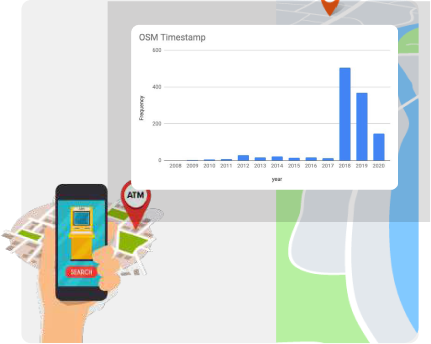Context
Have you ever wondered how a smartphone app knows the location of a store or restaurant just from you typing in the business’s name? The answer is a Point-Of-Interest (POI) database: a collection of place names — such as tourist attractions, businesses, addresses, and more — each associated with specific geographic coordinates. Type “Statue of Liberty” into map software and it is a POI database that will refer you to latitude 40.689167 and longitude -74.044444. The same database might contain your friend’s home address, a store at the mall, and everything in between.
As anyone who has driven up to a recently-closed restaurant can tell you, POI databases are only useful with updated information. It’s one thing to drop pins on a map to create a POI database. The challenge is validating, maintaining, and updating each entry. In remote or developing parts of the world, the challenge is even greater.
Premise’s ability to crowdsource geolocated data from anywhere on the globe makes it a perfect tool for keeping POI databases updated and accurate, no matter where the points of interest are.
Study
To demonstrate Premise’s ability to efficiently validate and update points of interest on a global scale, we ran a test of OpenStreetMap (OSM), an open-source POI database, and its listings of automated teller machines (ATMs) in Kenya.
First we combined OSM’s listings with Premise’s own POI database.
When both datasets were combined:
- 535 Kenyan ATM locations were only listed in the OSM POI database (46.2% of that database’s total)
- 474 Kenyan ATM locations were only listed in the Premise POI database (41.9% of that database’s total)
- 1,009 locations were listed in both databases (44.1% of all ATMs)
The OSM database showed the vast majority of ATM listings as having been added in 2018 or later (chart at right) which led the Premise team to hypothesize that few updates to the database would be needed.
To validate the OSM database, Premise created location-based discovery tasks for a random sampling of the OSM database’s unique listings and distributed the discovery tasks to Premise Contributors in Kenya.
In each case, a Contributor would select the task on the Premise app, accept the terms of the task, and head to the specified location to verify the ATM was there as described.
Upon arriving at the specified location, the Premise Contributor would have three options:
- If the ATM was at the specified location and the name on the ATM matched the name in the OSM database, the Premise Contributor would capture photos of the ATM and verify the information as correct.
- If the ATM was at the specified location but the name did not match the OSM database, the Premise Contributor would capture photos of the ATM and enter the correct name.
- If no ATM existed at the specified location, the Premise Contributor would take photos of the empty location and report the absence.
Findings
In less than a week, Contributors completed a significant number of the tasks — and the results were not what the Premise team expected.
A surprising number of OSM’s listings were incorrect. Premise found 35.7% of the ATMs had a different name and 21.4% of the ATMs were not at their specified locations.
At right is an example of what can happen when a POI database entry is out-of-date. The OSM database (image 1) and Google Maps (image 2) both showed a branch of Chase Bank Kenya (CBK) at virtually the same location in Nairobi. An August 2017 photo from Google Local Guide (image 3) also showed a CBK at that location.
In September 2020, however, a Premise Contributor reported that the CBK location had rebranded as SBM Bank (image 4). Upon further research, it was discovered that SBM Holdings acquired CBK in August 2018, validating the new finding.

Implications
POI data enables much of the spatial data science we take for granted: turn-by-turn routing, footfall traffic, machine learning models, and more. As such, accurate POI databases are critical for anyone using physical, spatial data. Unfortunately, as demonstrated here, even the most popular open-source options cannot keep up with the pace of change on the ground.
Premise’s crowdsourced insights are ideal for maintaining the integrity of location-based data. In this experiment, Premise validated and updated dozens of Kenya OSM listings in less than 48 hours. In the process, Premise updated our own POI database and contributed new findings back to OSM.
With a global network of more than three million Contributors across 140 countries, Premise can measure everything from population sentiment and demographic data to location information — all of it on-demand and rigorously authenticated. No matter what insights you need, or where, Premise is ready to deliver facts on the ground.
Ready to experience a new kind of POI database validation?
Reach out to learn more at [email protected]

